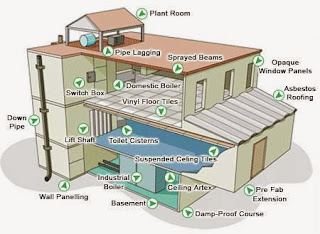Asbestos In The Home
Asbestos In The Home
Where is asbestos found?
It is not always easy to tell whether a product contains asbestos as modern asbestos-free materials often look similar - remember it is usually older products that contain asbestos. Common places where asbestos could be found include:
* Asbestos cement - cement roofs, wall cladding, downpipes and gutters, cement flues.
* Floor tiles, textiles and composites - textiles in fuse boxes, old fire blankets, heat resistant gloves. Composites can be toilet cisterns/seats and bath panels, window sills, bath panels.
* Textured and sprayed coatings
* Roofing felt
* Asbestos Insulating Board (AIB) - commonly used as fireproofing material and also partition walls, fireproofing panels in fire doors, lift shaft linings, ceiling tiles, soffits, panels below windows.
* Lagging and insulation - in or on heating systems such as round boilers, tanks or calorifiers and around pipework.
* Loose fill asbestos - in between cavity walls, under floorboards and in loft spaces.
What are the risks?
When asbestos materials age or become damaged they can release fibres into the air. These can be breathed deep into the lungs where they may stay for a long time, causing possible damage. Some people are exposed to low amounts of asbestos present in the atmosphere with no ill effects.
However when very high levels of asbestos fibres are inhaled there is a risk of developing serious lung diseases including pleural thickening, asbestosis and Mesothelioma. The symptoms of these diseases can often take between 20-40 years after exposure to materialise.
What should I do if I suspect there is asbestos in my home?
The general rule is to leave asbestos undisturbed. DIY work may result in brief but high levels of exposure to dangerous asbestos fibres. Asbestos is usually safe unless it is damaged or disturbed - for example by removing, drilling, sawing, scrubbing or sanding. If you believe you have asbestos materials in your home, extra care should be taken when undertaking any DIY. We would advise anyone against attempting to carry out work involving sprayed asbestos, lagging or insulating boards as this should always be undertaken by a licensed asbestos removal contractor.
REMEMBER:
* Avoid creating asbestos dust
* Avoid breathing asbestos dust
* Asbestos materials in good condition should be left alone
* Take extra care when undertaking DIY
* Dispose of asbestos properly
If you would prefer to have asbestos materials in your house removed by regulated specialist removers (and this should always be the case when dealing with pipe lagging, sprayed asbestos or loose fibrous insulation) then there are companies who will undertake such work. They are generally referred to as 'Licensed Contractors' and current information can be obtained from the Health and Safety Executive's Asbestos Licence Holders page.






0 comments: